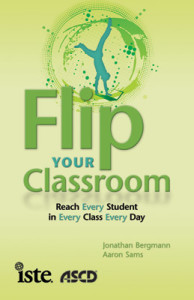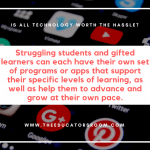To buy Cari’s book that details her sudden unemployment, “How to Finish the Test When Your Pencil Breaks” please click here.
Flip Your Classroom, by Jonathan Bergmann and Aaron Sams
Publishers: ISTE, ASCD, 2012
 The flipped classroom is already a familiar model across the country, and the amount of teachers implementing it has grown exponentially in the last few years. Now two of the first teachers to make their flipped classrooms accessible to educators around the country have written a book to explain how they did it. Flip Your Classroom: Reach Every Student in Every Class Every Day, by Jonathan Bergmann and Aaron Sams, is a quick and easy read that introduces teachers to the process of flipping a classroom and moving into a student-centered, mastery-based model.
The flipped classroom is already a familiar model across the country, and the amount of teachers implementing it has grown exponentially in the last few years. Now two of the first teachers to make their flipped classrooms accessible to educators around the country have written a book to explain how they did it. Flip Your Classroom: Reach Every Student in Every Class Every Day, by Jonathan Bergmann and Aaron Sams, is a quick and easy read that introduces teachers to the process of flipping a classroom and moving into a student-centered, mastery-based model.
The basic premise of a flipped classroom is that the information dissemination becomes opposite to that of the traditional classroom. Students get their initial information at home via videos of the content they need (usually these are lectures or webinars created by the teacher). The next day, the classroom becomes an active lab, where student-centered learning can blossom. As the authors describe, the teachers are “no longer the presenters of information; instead we take on more of a tutorial role.” Among the many benefits of the flipped classroom is that struggling students can get more help, and the time spent in the classroom is about active learning and collaboration. Essentially the role of the teacher changes from information delivery to student support and assistance.
In Flip Your Classroom, the authors lay out the basic method for flipping, including the tools necessary to make the process work. Other supports need to be in place: students need to be taught how to view the videos (Cornell Notes are employed for that process). Teachers themselves need to learn to film themselves providing the information, or learn how to create webinars for their students. This means that planning and preparation have to be in place before the “flip” occurs. The authors have a detailed FAQ section that addresses a lot of the questions I had as I read. I was very concerned about the thousands of schools that have populations without internet access at home. How can a flipped classroom work where technology is not equally available to students? The authors offer a variety of solutions: the video or webinar via the internet can also be done via smart phones, if a student doesn’t have any access to the internet, the videos can be made into files that can be used on computers, or burned onto dvd’s to be watched on television. The authors, who teach in a very rural community, note that they have not had any problems providing the home viewing necessary for their students, no matter the internet access capabilities.
There is a further advantage of a flipped classroom that really appeals to teachers who pursue student choice-based planning. The authors call it a “Flipped-Mastery Classroom.” Essentially, it is the combination of mastery learning and technology. It allows you to teach your students asynchronously. In other words, students who are learning for mastery can work at their own pace, and because you are not using up class time delivering information, you can assist each student where they are in their own process. They also argue that the flipped-mastery model gives students more instant feedback on their work, and it eliminates a lot of paperwork for teachers. Instead of set due dates where the teacher receives a pile of work to grade, the teacher can check for mastery and understanding all along the way. The work is being “graded” as it is done, at each student’s pace. Students begin to learn not only the content information, but how to master their own learning.
The book provides easy to follow, step-by-step instructions on how to flip your classroom. With a flipped class, your students will begin to take charge of their own education, and much of the burden of the learning process will shift from the teacher to the students. Teachers can model how to ask the right questions, how to engage in deep inquiry, and how to infuse learning with integrity. While they admit that there are no “silver bullet” answers to solve all the challenges of flipping a classroom, the authors are very thorough in providing many options for teachers to try.
The modern brick and mortar classroom is going to have to change in these fast moving times. Online education, blended schools, independent learning, and a variety of other technology-based learning options have arrived for students. The flipped classroom is one of the most basic, but most enriching ways to give students a new model for learning. Schools cannot hope to ignore the pervasive influence of technology in their students’ lives. In Flip Your Classroom, teachers can find dynamic ways to use that very technology to the benefit of the students and their own expertise.
Disclaimer: This book was provided to The Educator’s Room free of charge by the publisher. However, neither The Educator’s Room nor the reviewer received any compensation for this review. The opinions contained in this review are those of the reviewer alone and were written free of any obligation or agreement with the publisher. If you have any questions regarding book reviews, see our full disclaimer or contact the Book Review Editor.





Our entire staff just read this. I also teach science and like a lot of the ideas. My issue is understanding how to get the techie gizmos to create what’s in my head. Hopefully, when I get some tech assistance, I can make this work for me.
It definitely seems like a method shift that needs support for getting started – that’s great if your whole school is looking to do this!
Cari and Joules. I’m glad you enjoyed the book. We tried to make it accessible and readable. We hope this continues to help teachers.
It was a great read! I hope more schools will start providing training and support for teachers to flip their classrooms!
Our staff was divided into teams and made presentations of 2 of the chapters. My group actually flipped our presentation and made a video. It was our first one and was really funny. I’m not sure how to “get it out there” but we got “rave reviews”. LOL
If anybody needs training on flipping your class feel free to reach out to me. I am now doing it full time. You can connect with me by going to my blog. http://flipped-learning.com